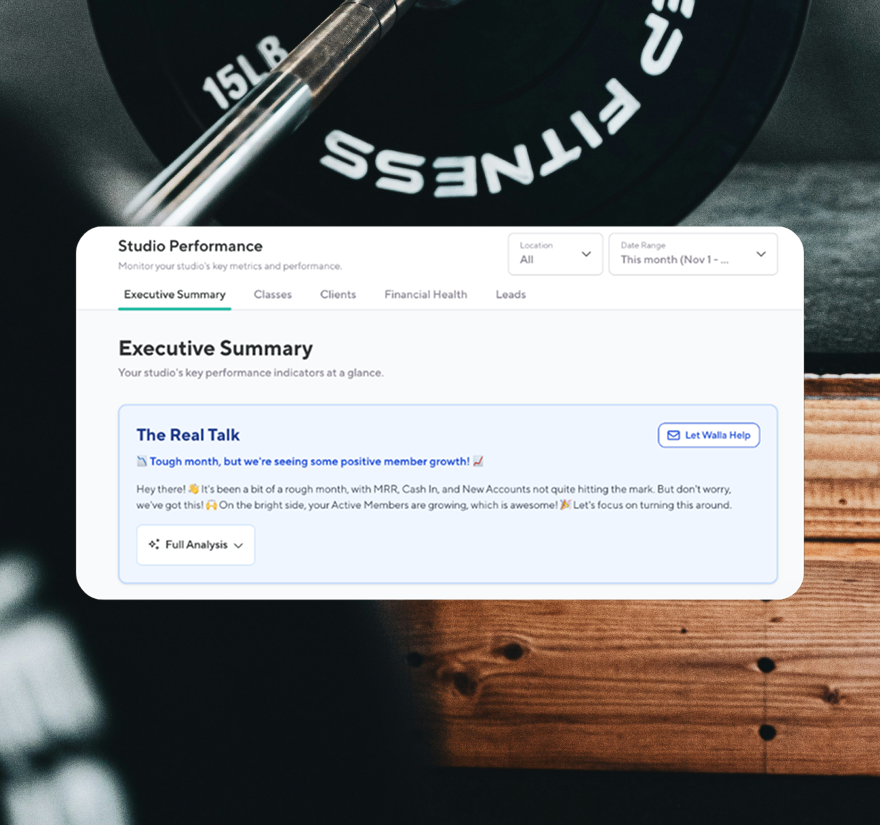
How to Determine the Value of Your Fitness Studio and Increase It
The fitness industry is highly lucrative, so knowing your value and increasing your appeal is crucial to improving the overall success of your studio and fitness brand.
Fitness is an important part of daily life, and recent data reinforces that. The global fitness industry is over $87 billion—and in the US alone, revenue in 2021 was in the $33.25 billion range, with 39% of Americans having a gym or studio membership. It doesn’t stop there, though. The fitness industry is expected to grow 171.75% in the next five years to $434.74 billion. So in an environment where well-being is a priority, how can you measure and increase what your fitness business is worth?
Working out the value of your gym or fitness studio requires a combination of financial analysis and industry knowledge. Here are some steps you can take to figure out your business valuation as a studio or gym owner:
Determine your gross revenue
Calculate your gross revenue by adding all the income generated from membership fees, personal training sessions, merchandise sales, and other revenue streams as a starting point for assessing the value of your business.
Analyze your operating expenses
Analyze your operating expenses by listing all the costs related to running your gym or fitness studio, including rent, utilities, insurance, equipment maintenance, payroll, and marketing expenses. Subtract your operating expenses from your gross revenue to calculate your net income.
Calculate your profit margin
Calculate your profit margin by dividing your net income by your gross revenue. A healthy profit margin is typically around 20% to 30%. If your profit margin is lower than this, it may indicate that your gym or fitness studio needs to operate more efficiently. Walla’s reporting dashboard dives into studio and financial metrics, including MRR (Monthly Recurring Revenue) and cash- and accrual-based revenue in an easy-to-understand format.
Analyze industry trends
Even as a small business, analyzing industry trends and how they are impacting your gym or fitness studio is beneficial. Look at factors such as consumer demand for fitness services, competition, and the availability of financing.
Consider your assets
Consider the assets that your gym or fitness studio possesses, like the value of your equipment, the value of any property you own, and any other assets that contribute to the value of your business.
Compare to industry standards
Compare the financial performance of your gym or fitness studio to industry standards. Look at industry benchmarks such as revenue per square foot, membership rates, and average client lifetime value.
Get a professional valuation
Get a professional valuation from an accountant, financial advisor, or business broker specializing in valuing gyms and fitness studios. They can provide an accurate and comprehensive business valuation based on market trends, financial data, and other factors.
There are several ways to add value and grow your fitness business. Here are some strategies to consider:
Focus on customer experience
- Provide personalized training plans: Offering customized training plans to your clients can help differentiate your business from competitors. Consider providing customized workout plans based on a client’s fitness goals, fitness level, and personal preferences.
- Nutrition coaching: Consider providing nutrition coaching along with fitness training to help clients achieve their fitness goals more effectively, and it can be an additional source of revenue for your business.
- Listen to your clients: Listening to clients is critical to understanding their needs and expectations. Make sure to ask for feedback regularly and adjust your services accordingly.
- Create a community: Creating a sense of community among your clients can help increase retention rates and word-of-mouth marketing. Try hosting group events, including volunteer opportunities, or setting up a private Facebook group for clients to connect.
Expand your services
- Offer online coaching: Online coaching is becoming increasingly popular and can help you reach a wider audience. Consider offering virtual training sessions, livestream classes, or online fitness challenges to give your clients flexible options that work for their schedule and budget.
- Group fitness classes: Group fitness classes with great instructors can help increase revenue and attract new customers, like yoga, Pilates, or HIIT.
- Nutrition Counseling: Offering nutrition counseling can help clients achieve their fitness goals and can be an additional source of revenue for your business.
Invest in marketing
- Develop a strong brand identity: Your studio’s brand identity is crucial for reflecting your business values and differentiating your fitness business from competitors.
- Create a marketing strategy: Focus on a marketing strategy that targets your ideal customer and focuses on your unique selling proposition, which may include social media advertising, influencer marketing, or email marketing campaigns.
- Establishing an online presence: Building an online presence can help attract new customers and increase brand recognition. Consider your website experience, setting up social media accounts, and publishing online content.
Offer promotions and discounts
- Run promotions: Promotions can help attract new customers and increase revenue. Consider offering a discount for first-time clients or running a referral program.
- Loyalty programs: Implementing a loyalty program can help retain existing clients and increase revenue. Consider offering rewards for reaching certain milestones or for referring friends.
Partner with local small businesses
Collaborate with other businesses: Connecting with other companies in the fitness industry can help increase brand recognition and attract new customers.
Keep up with industry trends
Stay up-to-date with trends: Staying up-to-date with the latest trends and developments in the fitness industry can help you stay ahead of the competition and appeal to a broader audience. Try attending industry events and consider subscribing to industry publications.
You can grow your gym and studio by focusing on customer experience, expanding your services, investing in marketing, offering promotions, and creating meaningful and beneficial partnerships with local businesses that can help you get more clients through your door. Remember, your gym or fitness studio's value can fluctuate based on factors such as industry trends, competition, and economic conditions. Regularly monitoring your financial performance and staying informed about industry trends can help you maximize the value of your business over time. And building a successful fitness business takes time and effort.
Ready to upgrade your studio?
Let us show what Walla can do for you!


Latest articles
Stay in the loop
Get webinar announcements, industry news, product feature release announcements, Walla insights, and more delivered straight to your inbox!


























%20-%202025-08-06T171547.606.png)

%20-%202025-08-07T222242.577.png)
%20-%202025-08-05T211155.122.png)
%20-%202025-08-05T164322.525.png)
%20-%202025-07-30T123218.666.png)


%20-%202025-02-07T095206.530.png)
%20-%202025-06-24T163406.559.png)

%20-%202025-06-23T164548.621.png)
%20-%202025-06-05T133636.454.png)


%20-%202025-04-29T110753.430.png)
%20-%202025-04-21T175210.819.png)
%20-%202025-04-21T143210.386.png)